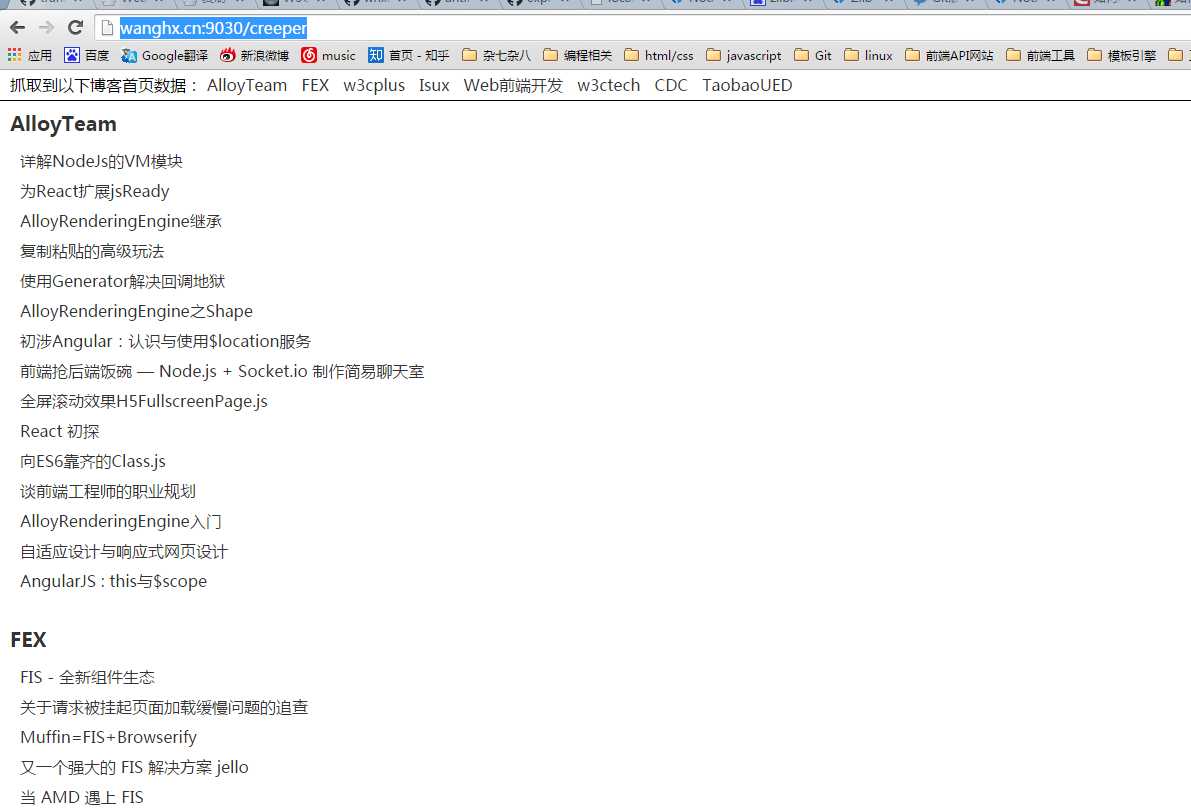标签:
此前在做项目的时候,一直用json文件用作模拟数据,后来发现了mock.js,于是就用了mock.js,再后来感觉这些数据再怎么模拟都是静态数据。所以就想用nodejs实现一个数据转发功能,在本地拉取服务端的数据。那时就简易做出了一个针对那个项目的数据拉取功能。而在最近,在看一些博客的时候,想把几个博客的页面内容全部拉取到一个页面来看。所以就把此前数据拉取功能稍作改造封装了一下。
做出的一个简易数据拉取demo:点我看效果

然后大概简述一下demo的实现。当作学习记录。
首先是数据转发模块,我将其封装了一下,封装成了transdata.js
"use strict"; var http = require("http"); var stream = require("stream"); var url = require("url"); var zlib = require("zlib"); var noop = function () {}; //两种请求 var transdata = { post: function (opt) { opt.method = "post"; main(opt); }, get: function (opt) { if (arguments.length >= 2 && (typeof arguments[0] == "string") && (typeof arguments[1] == "function")) { opt = { url: arguments[0], success: arguments[1] }; if (arguments[2] && (typeof arguments[2] == "function")) { opt.error = arguments[2]; } } opt.method = "get"; main(opt); } };
先是头部这段代码,就是简单的做了一点封装,封装成了两个方法,一个是get,一个是post,但是其实两个最终调用的都是main方法。其中,opt则是要传入的参数。参数包括了url、请求对象,响应对象等。
main方法如下
//转发请求主要逻辑 function main(opt) { var options, creq; // res可以为response对象,也可以为一个可写流,success和error为请求成功或失败后的回调 opt.res = ((opt.res instanceof http.ServerResponse) || (opt.res instanceof stream.Writable)) ? opt.res : null; opt.success = (typeof opt.success == "function") ? opt.success : noop; opt.error = (typeof opt.error == "function") ? opt.error : noop; try { opt.url = (typeof opt.url == "string") ? url.parse(opt.url) : null; } catch (e) { opt.url = null; } if (!opt.url) { opt.error(new Error("url is illegal")); return; } options = { hostname: opt.url.hostname, port: opt.url.port, path: opt.url.pathname, method: opt.method, headers: { ‘Accept-Encoding‘: ‘gzip, deflate‘, ‘Accept-Language‘: ‘zh-CN,zh;q=0.8,en;q=0.6,ja;q=0.4,zh-TW;q=0.2‘, ‘User-Agent‘: ‘Mozilla/5.0 (Windows NT 6.1; Win64; x64) AppleWebKit/537.36 (KHTML, like Gecko) Chrome/43.0.2357.37 Safari/537.36‘ } }; // 如果req为可读流则使用pipe连接,传输数据,如果不是则直接写出字符串 if (opt.method == ‘post‘) { if (opt.req instanceof stream.Readable) { if(opt.req instanceof http.IncomingMessage){ options.headers["Content-Type"] = opt.req.headers["content-type"]; options.headers["Content-Length"] = opt.req.headers["content-length"]; } process.nextTick(function () { opt.req.pipe(creq); }) } else { var str = ((typeof opt.req) == "string") ? opt.req : ""; process.nextTick(function () { creq.end(str); }) } } else { process.nextTick(function () { creq.end(); }) } creq = http.request(options, function (res) { reqCallback(opt.res, res, opt.success) }).on(‘error‘, function (e) { opt.error(e); }); }
首先将opt参数进行一些错误处理。其中res可以为响应对象,也可以为一个可写流。而success和error就是请求成功和失败后的回调,同时再将url转成对象方面后面使用。因为要在后台发起一个请求,所以请求的参数options是必须的啦。
写好options后再判断要转发的请求是post还是get,如果是post而且传入的参数req是一个请求头或者可读流,则直接使用pipe连接res,进行数据传输。如果req是string,则直接写入。发起请求获得响应后则调用reqCallback方法,对数据进行处理。
reqCallback方法如下:
//请求成功后的回调 function reqCallback(ores, res, callback) { if (ores) { ores.on(‘finish‘, function () { callback(); }); if (ores instanceof http.ServerResponse) { var options = {}; //复制响应头信息 if (res.headers) { for (var k in res.headers) { options[k] = res.headers[k]; } } ores.writeHead(200, options); } res.pipe(ores); } else { var size = 0; var chunks = []; res.on(‘data‘, function (chunk) { size += chunk.length; chunks.push(chunk); }).on(‘end‘, function () { var buffer = Buffer.concat(chunks, size); //如果数据用gzip或者deflate压缩,则用zlib进行解压缩 if (res.headers && res.headers[‘content-encoding‘] && res.headers[‘content-encoding‘].match(/(\bdeflate\b)|(\bgzip\b)/)) { zlib.unzip(buffer, function (err, buffer) { if (!err) { callback(buffer.toString()) } else { console.log(err); callback(""); } }); } else { callback(buffer.toString()) } }) } }
对数据的处理比较简单,如果res是响应对象,则直接通过pipe连接,如果不是,则获取到数据,如果数据用gzip压缩了,则用zlib进行解压,然后放在回调中即可。
transdata的调用比较简单,像get直接:
transdata.get(url , function(result){})
而我项目中用到的数据转发的是用到post请求,也很简单,直接:
var transdata = require("transdata"); var http = require("http"); http.createServer(function(req , res){ transdata.post({ req:req, url:‘http://XXX/XX:9000/getdata‘, res:res, success:function(){ console.log("success"); }, error:function(e){ console.log("error"); } }); })
transdata写完,再回到上面那个demo的实现上来,既然有了transdata,获取数据就很容易了。代码如下:
var creeper = function(req , res , urlObj){ var header = fs.readFileSync(baseDir + "header.ejs").toString(); var contents = fs.readFileSync(baseDir + "contents.ejs").toString(); var foot = fs.readFileSync(baseDir + "foot.ejs").toString(); res.writeHead(200 , {‘content-type‘:‘text/html;charset=utf-8‘}); res.write(ejs.render(header , {data:ids})); console.log("开始采集数据..."); var count = 0; for(var i=0;i<ids.length;i++){ (function(index){ var id = ids[index]; var nowSource = source[id]; transdata.get(nowSource.url , function(result){ count++; console.log(">【"+id+ "】get√"); var $ = cheerio.load(result); var $colum = $(nowSource.colum); result = []; $colum.each(function(){ result.push(nowSource.handle($(this))) }); if(typeof +nowSource.max == "number"){result = result.slice(0 , nowSource.max)} if(result.length){ var data = {}; data[id] = result; result.index = index; var html = ejs.render(contents , {data:data}); html = html.replace(/(\r|\n)\s*/g , ‘‘).replace(/‘/g , "\\‘"); res.write("<script>loadHtml("+index+" , ‘dom_"+index+"‘ , ‘"+html+"‘)</script>"); } if(count == ids.length){ console.log("数据采集完成.."); res.end(foot); } }) }(i)) } };
获取到数据,数据为html信息,而处理html信息的工具就是cheerio,用法跟jquery的选择器一样,就用cheerio对数据进行操作并且获取自己需要的数据,这些就不进行赘述。相对比较简单。
整个项目源代码的github地址附上:
https://github.com/whxaxes/node-test/tree/master/server/creeper
同时附上transdata.js的github地址:
https://github.com/whxaxes/transdata
有兴趣的可以一看。
标签:
原文地址:http://www.cnblogs.com/axes/p/4466496.html